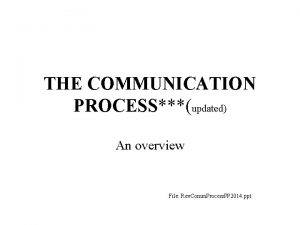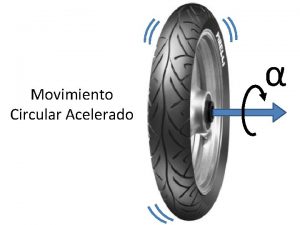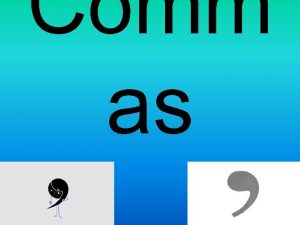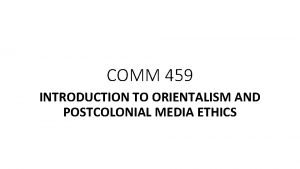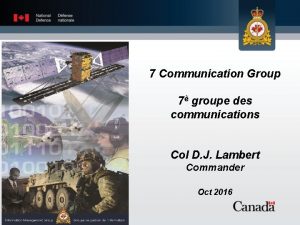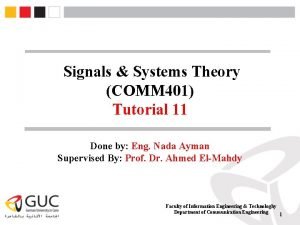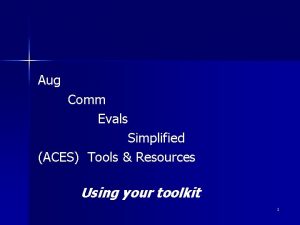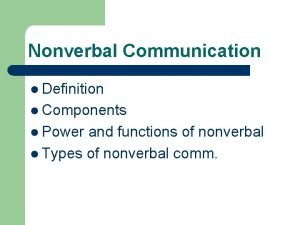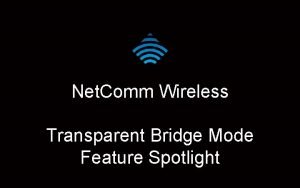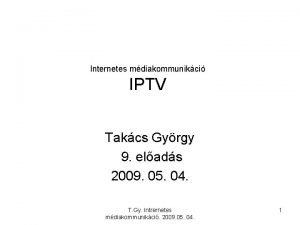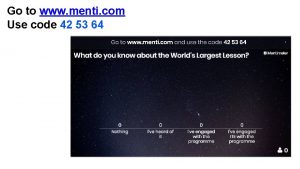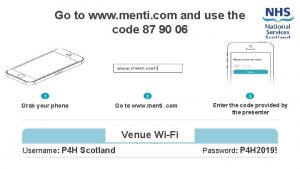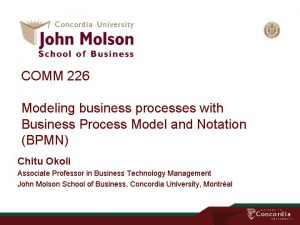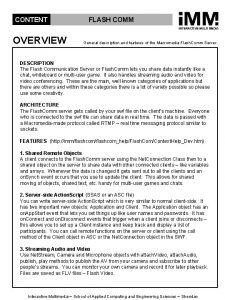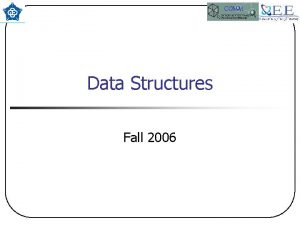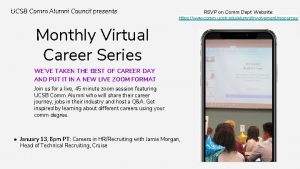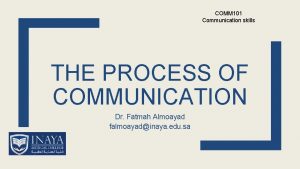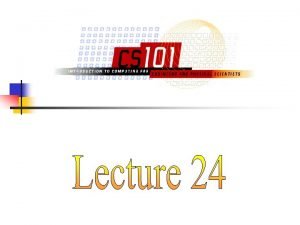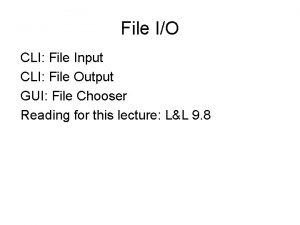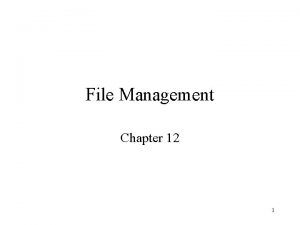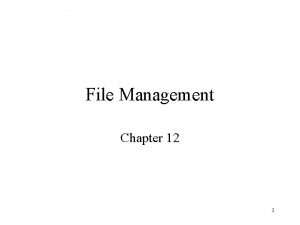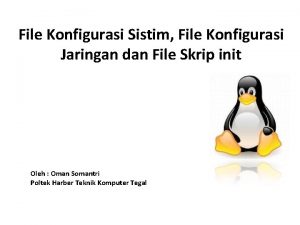THE COMMUNICATION PROCESSupdated An overview File Rev Comm


































- Slides: 34

THE COMMUNICATION PROCESS***(updated) An overview File: Rev. Comm. Process. PP 2014. ppt

DEFINITIONS • Communication-gaining mutual understanding between the sender and receiver. (s).

TYPES OF COMMUNICATION Non-verbal—unspoken—usually body language (folded arms, frowning, rolling your eyes) Interpersonal----communication between two people Intrapersonal –what you say to yourself (spoken or unspoken) Ex. Shopping alone Dyadic—communication between two persons

COMMUNICATION PROCESS (Linear Model) • Message—Information being transmitted • Interference (or noise) in channel-anything that hinders message from being received • Channel-means by which the message is communicated • Listener (Receiver)-individual the message is intended for • Sender-individual who is conveying the message • Encoder - puts thoughts into symbols and gestures • Decoder- makes sense of the message

DEFINITIONS Noise in Channel • Interference-Same as noise in channel(something that blocks the communication process) • Listener: Person message is intended for. When the listener fails to “get” the message, there is no communication. Similarly, if there is no listener, communication does not take place. • Channel-means by which message is communicate (by voice( through the airways, and atmosphere) telephones (including cell phones), radio/TV. • Sender—Individual conveying the message Listener Sender

Examples of Noise in Channel • Someone interrupts you are speaking • Someone walks in door as you are delivering a speech • Someone whispers to another student or talks during your speech • A fellow student purposely distracts you during your speech

OTHER EXAMPLES OF NOISE IN CHANNEL • Radio station loses the signal • Cell phone runs out of power or you lose the signal • Cable wires buried underground accidentally cut during construction • Cable goes “out” and message cannot be delivered • Noise can also be called INTERFERENCE

LISTENING-a vital part of the Communication Process • Five part process: receiving/understanding/remembering /evaluating/responding • ACTIVE LISTENING-- Sending back to the speaker what you THINK they meant. Two parts to this: • Content: You understand the message the sender is trying to convey • Feeling: You understand the underlying feelings of the speaker (about the message conveyed)

ACTIVE LISTENING Definition: Sending back to the speaker what you, as the listener, think the speaker MEANT, both in content and feeling THREE WAYS TO ACTIVELY LISTEN § Paraphrase the speaker’s thoughts § Express understanding of the speaker’s feelings § Ask relevant questions (if you are informed on subject) PLEASE NOTE: IF THE LISTENER DOE NOT GET THE MESSAGE, THERE IS NO COMMUNICATION. The process has failed.

EXAMPLE-ACTIVE LISTENING Scenario: group of students discussing project after class SPEAKER: That “witch “ of a teacher gave me a lousy C on the paper I wrote. I really worked hard on that and I got a lousy C. Listener 1: That not too bad; most of the students go the same grade. I got a C too. Listener 2: SO what? This is your last semester high school. What cares about grades anyway? Listener 3: You should be pleased with a C. Matt and Michael both failed and John and Jimmy both got D’s. Listener 4: You got a C on that paper you were working on for the last three weeks. You really sound angry and hurt.

Analysis of student scenario • TO SUMMARIZE: All four listeners tried to make the speaker feel better • L-1 and L-2 both tried to lessen getting a C. This was an inappropriate response. May be well-intended by does little to promote meaningful communication and understanding. • L-3 makes the C grade take on a more positive meaning • NOTE: All three of these listeners are REALLY SAYING that the speaker should not be feeling as he/she does. • L-4 was the only one who practiced active listening. Sent back to the speaker what he said and how he felt (Content and Feeling)

Linear Model goes out; Is replaced by Transactional Model • At certain point, communication researchers decided the linear model was incomplete…it was all about what the sender DOES to the receiver and • It lacked back and forth interchange • It was replaced by the Transactional Model


Transactional Model • Words sender and receiver replaced by “Communicator” • This was to represent fact that communicators often send messages simultaneously rather than back and forth at same time (as shown in linear model) • SEE EXAMPLE ON NEXT SLIDE » Rev. Comm. Process. PP 2014. ppt

Sample of Transactional Model in use • Your roommate wants to have a conversation about how to handle chores • Communicator #1 “I want to talk to you about choresespecially about sharing duties to clean the kitchen” • Communicator #2 -Grimaces and clenches his jaw (nonverbal response) • Your reaction leads your roommate to respond defensively, saying “Now you wait a minute…” • Channels have a significant role in this model and play a significant part in getting the message across.

More examples of differences in models (cont. ) • Two examples • To say “I love you, ” you can use the channel of the AIRWAYS (face-to-face person) or by sending a text message or letter, by sending flowers and a card or in a voice mail. Choice of channel use affects effectiveness of message • A study of over 1, 000 cell phone users, 45% ended a romantic relationships by text message (response might be —”great, she didn’t even had the guts to tell me to my face”)

Noise-difference in teach model • Linear model focuses on external noise (door slamming as you speak) • Transactional model shows that noise can be internal (within the communicator) • Types are 1) Physiological—involves biological factorsstudent has the flu and feels so poorly that they cannot think clearly enough to “get the message” • 2) Psychological-Affects a person’s inability to receive the message. Ex. Student might become so upset about learning she failed a test that she “blocks out” the instructor’s message (who wants to show her where she went wrong.


The Johari Window Knowing more about yourself and others

Definition of… • The Johari Window is a communication model that can be used to improve understanding between individuals. • Developed by Joseph Luft and Harry Ingham (the word “Johari” comes from Joseph Luft and Harry Ingham).

Two key ideas behind the tool: • Individuals can build trust between themselves by disclosing information about themselves. • They can learn about themselves and come to terms with personal issues with the help of feedback from others.

More information on Johari Model § Using the Johari model, each person is represented by their own four-quadrant, or four -pane, window. • Each of these contains and represents personal information - feelings, motivation about the person, and shows whether the information is known or not known by themselves or other people.

The four quadrants are: • Quadrant 1: Open Area • What is known by the person about him/herself and is also known by others. • Your eye color • Your major • Your hometown • What’s on your FACEBOOK page • Your favorite food/video game/movie

• Quadrant 2: Blind Area (or “Blind Spot”) • What is unknown by the person about him/herself but which others know. • This can be simple information, or can involve deep issues (for example, feelings of inadequacy, incompetence, unworthiness, rejection) which are difficult for individuals to face directly, and yet can be seen by others. EXAMPLE • Boyfriend was cheating on girlfriend-they were both in my Speech class in the same quarter. Everyone in class seemed to know but the girlfriend.

• Quadrant 3: Hidden or Avoided Area • What the person knows about him/herself that others do not. Most SELF DISCLOSURE comes from this area Example: A person is HIV positive but he has not shared this information with anyone.

• Quadrant 4: Unknown Area • What is unknown by the person about himself/herself and is also unknown by others. EXAMPLES: • An individual with cancer has no idea that she has cancer and neither does her physician (it has not been diagnosed yet) • An individual has a very interesting dream. Wakes up and forgets it immediately. She has no idea what the dream was and no one else does either.

Key Points: • In most cases, the aim in groups should be to INCREASE the Open Area for every person. • Working in the Open Area usually allows for enhanced individual and team effectiveness/ productivity. • The Open Area is the ‘space’ where good communications and cooperation occur, free from confusion, conflict and misunderstanding. • Self-disclosure is the process by which people expand the Open Area. • By encouraging healthy self-disclosure, you can build a stronger and more effective team.

JOHARI WINDOW DIAGRAM GOES HERE

WHY UNDERSTANDING JOHARI MODEL IS IMPORTANT • Helps one understand the dynamics of teamwork. • TWO QUADRANTS ARE INVOLVED—Open and Hidden • Larger OPEN area (for healthy team) is what you strive for. • Why? Because then cooperating among team members can occur. • If too many team members fall into the HIDDEN quadrant, good cooperation among team members is impossible. • .

Johari Model & Self-Disclosure • SELF DISCLOSURE-Definition: A type of communication when you reveal information about yourself. • Term most often refers to information that is normally part of your “HIDDEN SELF” (no one knows about it but you) • Sometimes it is HEALTHY---unimportant information that you could not be judged by • Sometimes it is UNHEALTHY—private information that you disclose (that should remain private) because this information about yourself could be used against you. • (SEE SAMPLES ON NEXT SLIDE)

ALL ABOUT SELFDISCLOSURE Be careful, the information you disclose to strangers might come back to “bite you”

Dangers of Self-Disclosure • GOSSIP—this is a school of 2200 students. • SELF-DISCLOSURE HEARD BY ALL STUDENTS IN SPEECH CLASS THAT DAY: • During a speech, a male student discloses that he is a polygamist (five students in this Speech classes are in his other classes) • A female student used her speech of self-introduction to announce that she was lesbian and turned to a number of guys sitting at the back of the room and says “Sorry guys, I’m not available. ” • A female student stands to introduce herself and announces that she is an exotic dancer…before closing she gives them her stage name “RUBY RED” and invites them a free cover charge to visit a certain club on Richmond where she dances on Friday nights.

More examples Statements announced or overheard in Speech Class. • • On day of knife skills test, a Culinary student in same speech class as girl at next table whispers to his friend next to him and says , “ See that girl taking the test, she told a story in speech class about how she came close to taking her boyfriend’s life with a knife much like she has in her hand. ” Culinary student discloses to his team members that he is at AIH studying culinary arts because a restaurant is about the only place which hires convicted felons. An older male student in culinary, during a speech of self-introduction, stands up and states, “the story of my life is not very interesting because I have been incarcerated most of my life. ” While making brioche dough on a given day in Culinary, a female student shares with her team that she has been sexually abused by her Mother’s second husband her maternal Grandfather.

 Rev.comm
Rev.comm Formulas mcua
Formulas mcua File-file yang dibuat oleh user pada jenis file di linux
File-file yang dibuat oleh user pada jenis file di linux Market overview managed file transfer solutions
Market overview managed file transfer solutions Proper comm
Proper comm Goals of interpersonal effectiveness
Goals of interpersonal effectiveness When to use a comm
When to use a comm Sistem komunikasi intrapersonal
Sistem komunikasi intrapersonal Intrapersonal comm
Intrapersonal comm Roborio comm light red
Roborio comm light red Introduction to orientalism
Introduction to orientalism Defsoc
Defsoc Comm 401
Comm 401 Mobilecric.comm
Mobilecric.comm Awan diles
Awan diles Catos letters
Catos letters Rec net
Rec net Comm 486
Comm 486 Aug comm device
Aug comm device Menti.com
Menti.com Nonverbal communication definition
Nonverbal communication definition What is transparent bridge mode
What is transparent bridge mode Beeg comm
Beeg comm Go to menti
Go to menti Mit be comm lab
Mit be comm lab Menti.comcom
Menti.comcom Www.menti-com
Www.menti-com Comm portal
Comm portal Www.menti/com
Www.menti/com Go to www.menti com
Go to www.menti com Comm operator
Comm operator Comm operator
Comm operator Comm 226 quiz
Comm 226 quiz Comm 226
Comm 226 Physical image vs logical image
Physical image vs logical image
